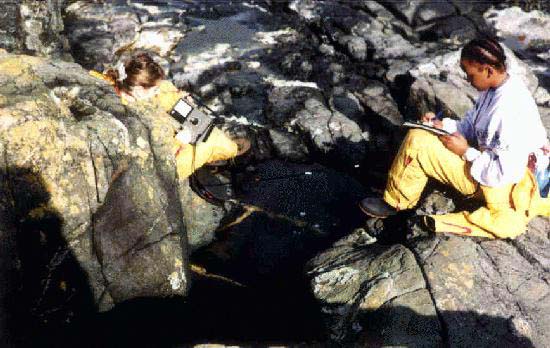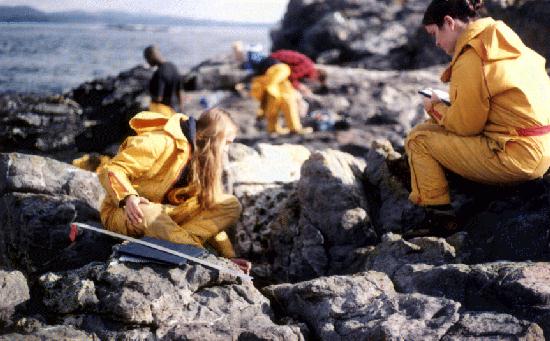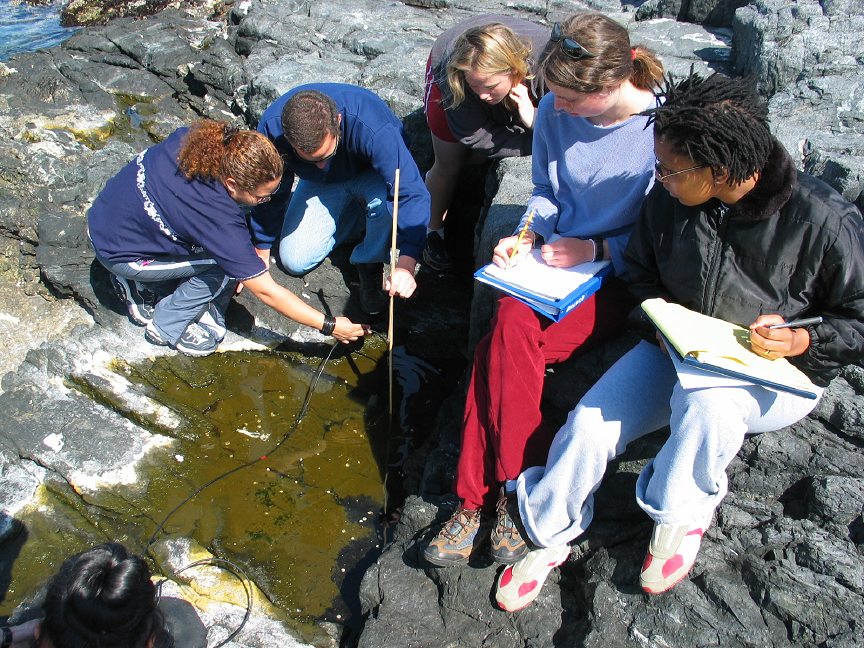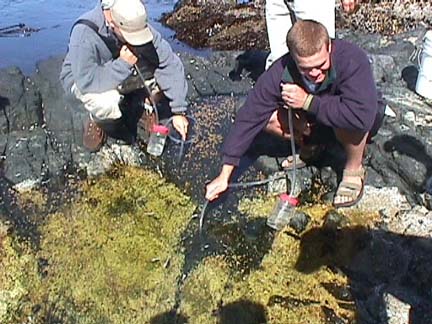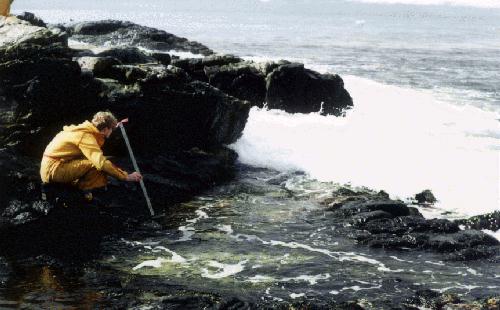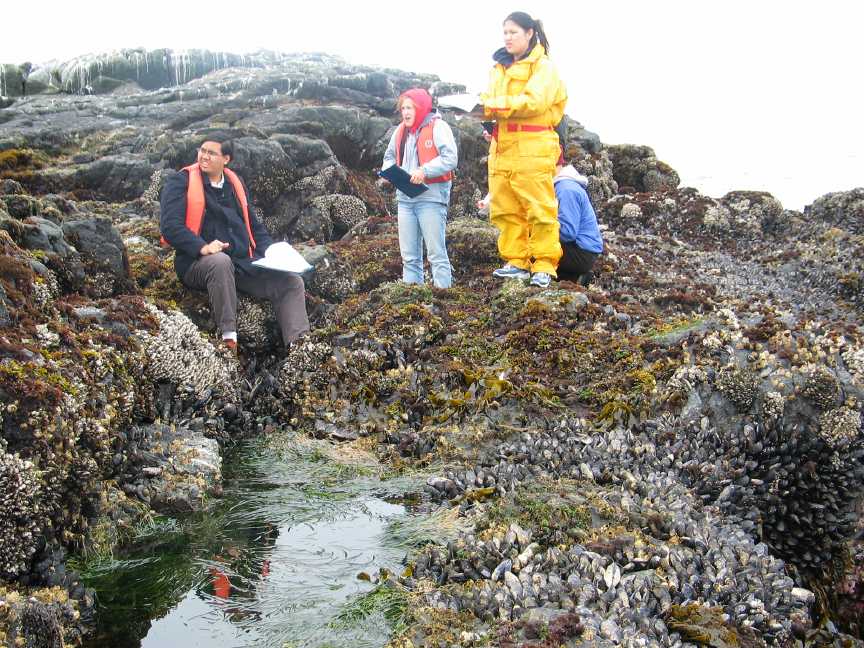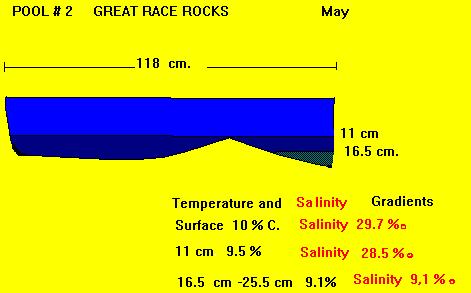| BACKGROUND :It is intended that,students can access this file as a resource for an assignment in high school biology or college ecology coursers. For several years now, students of biology and environmental systems classes of Pearson College have been doing informal studies on the tidepools of Race Rocks. In April of 1996 we started to make some systematic records of some of the pools and establish a data base to which we could add in the future. The following represents the beginning of our tidepool work. |
| PURPOSE:by Michal Kozak
Tide pools are completely separate systems from that of the rocky shore. They form a sort of intermediate situation between the coastal sea and the well-drained intertidal zone, and thus give insights into factors controlling the structure and function of these two bordering systems. Tide pools are suitable for various student projects, similar to the one that we did. It is because of the amazing diversity of life and the wealth of physical, biological, and chemical processes in them. For instance, they show the importance of the desiccation factor on the open shore and they are also ideal observing pH and buffering phenomena. Their generally manageable proportion and simple ecosystems mean that thorough projects in tide pools can be undertaken in a short period. PROCEDURE: On Friday, 12th of April/96 during our block of environmental systems we went by boat to Race Rocks. We moored at the docks and then we went through across the island to the rocky shore. Besides numerous seagulls we saw there several tidepools. The tide level at that time was quite high (1.8 m), so at a lower tide we could have seen more tide pools. There we observed 3 different tide pools that were found close to the red peg, number 6. At each tidepool we measured the following :
We recorded our results and processed them ,thus trying to find general trends in the physical factors observed. The next Wednesday, we went to Race Rocks again. However, this time the tide was lower (0.9 m) which enabled us to observe tide pools at lower levels. We again followed the same procedure as described above. 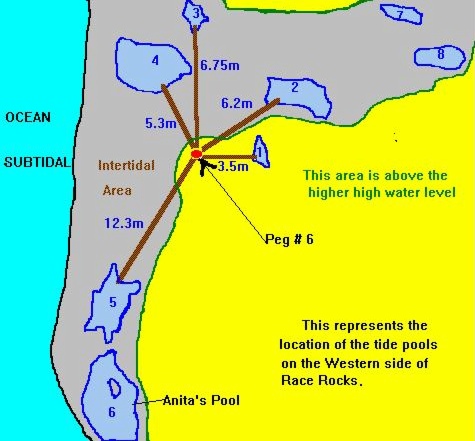
This map presents the horizontal distribution of the tide pools around a permanently installed reference peg on the Western side of Great Race Rock. We have over 15 of these reference pegs around the island. Many are used for subtidal transect work and surveys. Peg #6 is particularly well suited for intertidal work on this Western side of the island. Intertidal transect photos from the peg#5 location may be found at the Race Rocks Section of The Transect File. The magnetic compass bearings of the pools from the reference peg are listed below: Pool 3= 0 degrees. (compass bearing)
Pool 6= 205 degrees (compass bearing). . See the reference below to research work done on this pool by Dr. Anita Brinckmann Voss.
THE TEMPERATURE OF THE TIDE POOLS. Temperature of tide pools was measured for overall differences between pools and for stratification within pools BIOTIC FACTORS OF THE POOLS A species list was made of the pools and graphs were made to compare the numbers of plant and animal species in each pool.
A profile of the vertical distribution of the pools was done by Tamas in the spring of 1998. From this we can make hypothesis about correlations with vertical levels and differences in the pools. THE pH OF THE POOLS
PUBLICATIONS ON TIDEPOOLS:Brinckmann-Voss, A. 1996. Seasonality of Hydroids (Hydrozoa, Cnidaria) from an intertidal pool and adjacent subtidal habitats at Race Rocks, off Vancouver Island, Canada. Scientia Marina, 60 (1): 109-117This work done recently by Dr. Anita Brinckmann-Voss was in a tidepool (#6) adjacent to the ones we have been studying at Race Rocks. The purpose of her paper was “to provide information on the hydroids of a cold temperate tide pool with regard to seasonal occurrence, growth and regression, and reproductive periodicities.” She has reported an assemblage of 27 hydroid species and tracked their seasonal occurrence, growth, sexual maturity and systematics. Possible causes of hydroid species diversity are considered, including location of tide pool in an area of rapid tidal rapids, and shading by surfgrass and rock cliffs during low tide.Thomas, M.L.H.-1983. Marine and Coastal Systems of the Quoddy region, New Brunswick, Canada. Can. Spec.Publ.Fish.Aqua.Sci. 64: 1-306 This reference has been of use to us because it provides a classification scheme for tide pools and a series of charts and graphs which have provided useful models for our studies. Thomas notes that “Although there is a wealth of information on seashores, there is a paucity of information on tidal pools, particularly their functional aspects. There are no texts on pools and those on shores in general (Amos 1966; Carefoot 1977; Clayton 1974 ; Lewis 1964; Southward 1966; Stephenson and Stephenson 1972; Yonge 1949) provide little critical information about tidal pools. This undoubtedly results from the scarcity of scientific papers on tidal pools.”This file was prepared by the students of the Environmental Systems Classes and their teacher G.Fletcher. |
Race Rocks Ecological Reserve-
marine ecology educational resource, remote-control webcams,elephant seal colony,Sea lion haulout,sustainable energy, solar energy

